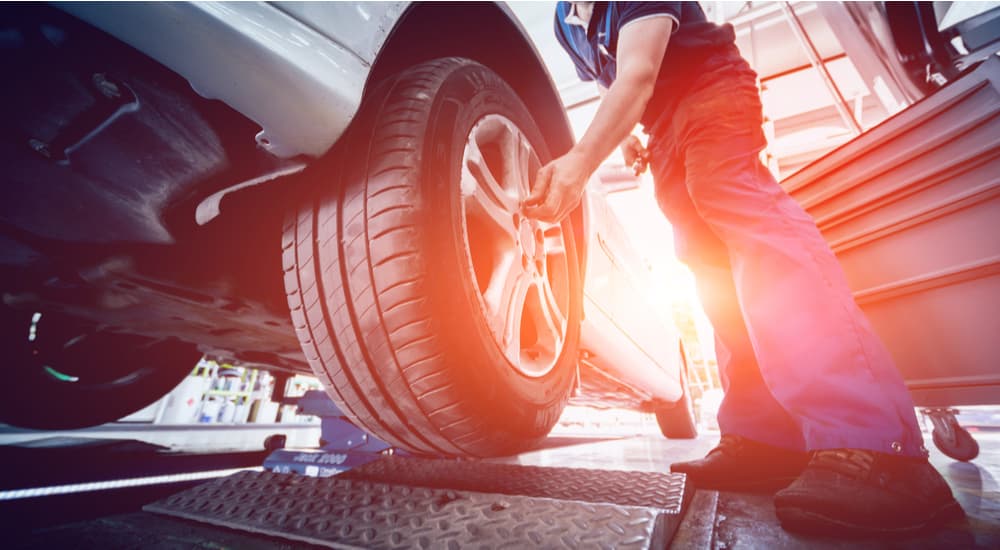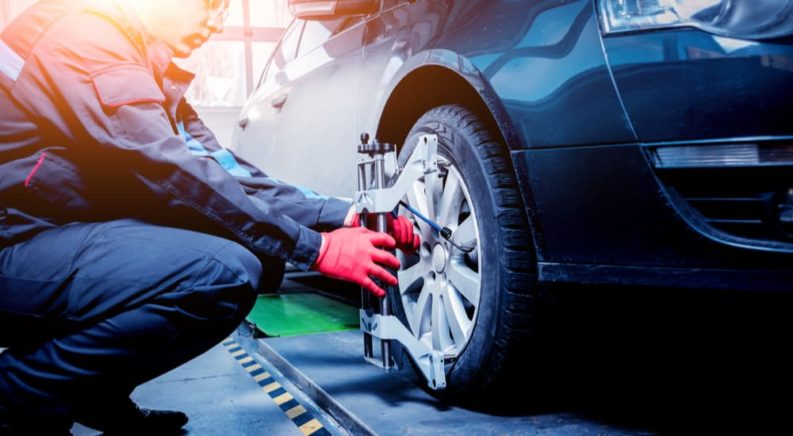Once upon a time, I didn’t really think about the alignment of tires. I assumed that wheels were upright, turned on a vertical axis, and pointed straight ahead, and they just were that way. Now that I’m older, wiser, and uncomfortably aware of the fact that at an infinitesimal level, nothing actually touches anything else but is instead held at a fixed distance by nuclear forces, I know better about wheels. Setting the optimal alignment of each wheel – and that doesn’t necessarily mean perfectly upright and forward-facing – is a geometrically and mechanically involved task. As one who has always been better at reading about mechanisms than adjusting them, even thinking about the skills and tools needed for an auto-alignment has me searching for “auto alignment near me” in a hurry.
Maybe you’re like me – or maybe you already have your wrench in hand, and you’re scrolling ahead for advice on how to proceed. Either way, it’s interesting to look at how professional mechanics would handle a process like this compared to the way you can do it in your own garage, so today, that’s what we’re going to do!
Alignment Variables
The auto or wheel alignment has a significant influence on factors like tire wear, fuel efficiency, handling stability, and most noticeably on how straight the vehicle tracks. Adjustments can be made to prioritize sharp cornering ability or balanced treadwear, and recommended specs from manufacturers and skilled hobbyists are available across the web for virtually any model and whatever purpose you might have. But what do the specs all mean?
The key terms to remember are caster, camber, toe, and thrust. Thrust addresses the alignment of the rear axle to the centerline and front axle – what’s the direction of thrust compared to the direction you want to drive in? Toe is also easy enough to understand, addressing whether the fronts of the tires point away from or towards the vehicle (toe out and toe in, respectively). Camber measures how upright the tire is – wheels that look like they’re tilting in towards the car have negative camber, while those tilting out have positive camber. Lastly, caster measures the steering axis – think of how the Earth spins on a tilt, resulting in seasons for the upper latitudes of the world. That’s like saying the Earth has a “caster angle” of 23 degrees.
What does each of these do for the vehicle? Thrust is pretty simple – you want your rear axle to be perpendicular to the centerline and parallel to the front so that all your horsepower is pushing forward and not even a little bit sideways. A little bit of toe-out improves the stability of your steering, so the wheel won’t feel jittery on the highway. Negative camber is popular for taking sharp corners at high speed – as the car leans away from the center of the turn, grip increases for a wheel on the outside edge with negative camber, improving the handling limits. Caster can strongly impact how easily your steering recenters – a little bit of positive caster, with the steering axis angled back towards the driver, helps the wheels recenter themselves quickly and easily.
Alignment Process and Tools
If you’re like me, all of that was enough to throw your hands up in the air and look for a nearby alignment shop. Otherwise, you’re probably champing at the bit to get to work!
To perform an alignment in either setting, the vehicle needs to be lifted so that you can work underneath it, but resting on its wheels to reflect real loading conditions, and it must be able to turn the front wheels on that surface to measure caster. You can achieve this with 4 floor jacks, 4 stands to set the wheels on, and low-friction surfaces on top of those stands to enable rotation. A professional setup will use a more complicated alignment system, usually including a drive-on lift with turn plates.
You should inspect your tires and suspension at this point. A mechanic will ensure that all components are in good working order – if they’re not, the alignment won’t last for long, so there’s little point in proceeding without replacing those parts first. Then the tire pressures need to be properly set, finally creating the most realistic driving stance possible for the vehicle.
Toolkit at Home
To carry out this process at home, you’ll need your own set of wrenches and sockets, as well as a tape measure, some string, and camber/caster/toe measurement plates – these can be purchased from a variety of sources or made yourself out of metal, wood, or even thick cardboard. You’ll need something to lock the steering wheel into the center position and something to engage the brakes so that the car doesn’t move around while performing measurements and adjustments. The last thing you’ll need is time; I appreciate that Donut Media’s demonstration of this process shows exactly how much time and effort their star had to put into doing his first home alignment.
Toolkit at the Shop
A professional garage is more likely to have made capital investments in equipment to do this quickly and easily. The Hunter HawkEye Elite is an example of such a system, pricing upwards of $30,000 brand new but eliminating much of the hassle and tedium from preparing the vehicle and checking the alignment measurements. You’ll still need to secure the steering wheel and brakes, and your standard hand tools are needed to make the adjustments themselves, but this type of system eliminates a ton of time spent propping up the vehicle and measuring the adjustments.
At the core of this system is a set of laser sensors that the technician mounts to the center of each wheel. The system software helps direct and record measurements; its feedback is instantaneous, eliminating the need to check and double-check with calipers or measuring tape. This can save hours on the total adjustment time since measurements are quick and accurate with little need for finesse.

Adjusting Alignment
Without getting into details, there’s a handful of connection points where eccentric bolts, sliding bolts, or shims are used to control the alignment angles of each wheel. The specifics depend entirely on the car – newer models often come with fewer degrees of freedom, and different suspension styles will have different adjustments to make. It’s probably an easy task to find information specific to your car online; of course, the professional systems usually have that built-in with pictures and instructions, as well as manufacturer-recommended specifications for general use, letting you know exactly what to adjust and what the general-use targets are (though you may have other ideas for other purposes).
Then you need to get your hands dirty and turn some screws to finesse the wheels to where you want them to go. This is where it’s critical that the brakes are on, the steering wheel is locked in the center, and the vehicle is properly loaded. Because adjusting some of these parameters influences others, there’s a specific recommended order of operations:
- Align the rear, then the front
- Adjust caster, then camber, then toe
Some caveats: caster applies to wheels that steer, so most rear wheels have no caster (some early-2000s Sierras and the brand-new Hummer EV are notable exceptions). Adjusting camber and then toe in the rear should correct any thrust without needing additional tweaks. Of course, not one size fits all – if you find recommendations specific to your vehicle which contradict what I’ve said here, let your model-specific instructions lead the way.
While a professional system can’t help you with making the adjustments, what it can help with is instantly telling you the impact of the change you made. So instead of loosening, adjusting, re-tightening, and then re-measuring half a dozen times or more before you’ve got the angles finessed just right, you can get that quick feedback and move on to the next adjustment, finishing the job before your next mealtime.
Then once you’re done and have re-tightened everything that you worked on, it’s time for a test drive! A good idea is to use a paint marker to indicate where every one of those bolts is set to, so that if something comes even a little bit loose during driving, you’ll easily be able to identify the culprit and reset it more tightly.
DI-Why?
That’s it! All there is to it. None of the work involved is particularly difficult, though it certainly requires a degree of skill and patience to achieve precise measurements and make fine adjustments on a vehicle. The need to lift, and then set down the lifted vehicle, makes this one a little more challenging than a typical DIY maintenance task, but it’s totally achievable if you’ve got the patience and interest to see it through. Or, you know, if you’ve got a buddy with a laser-guided alignment system in their garage.
For me, I appreciate the independence and satisfaction that comes from being able to do this yourself, and depending on who your mechanic is, it could really save a buck down the road to do this at home at regular intervals instead. But I appreciate even more that a mechanic can do in an hour what would take me a whole weekend because they’ve invested in their skills and in significantly more advanced tools.

